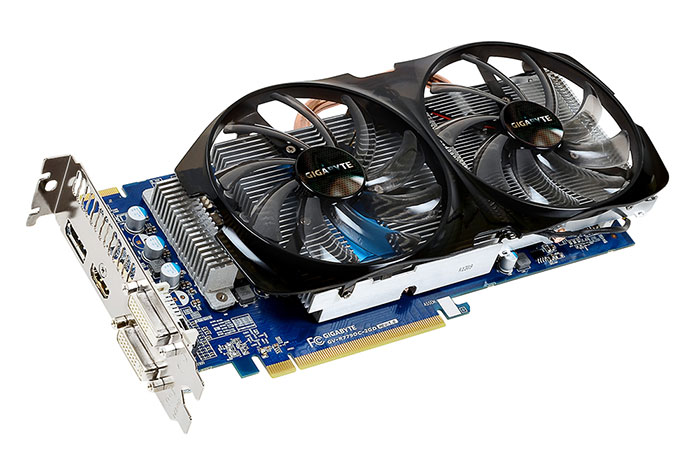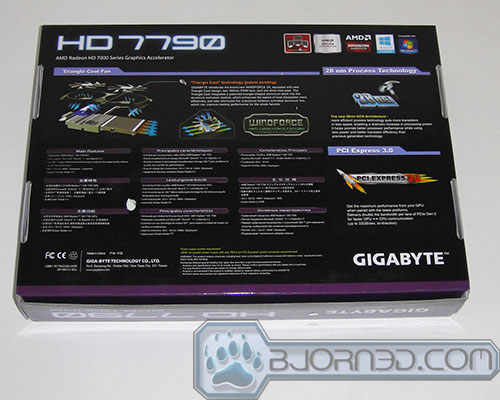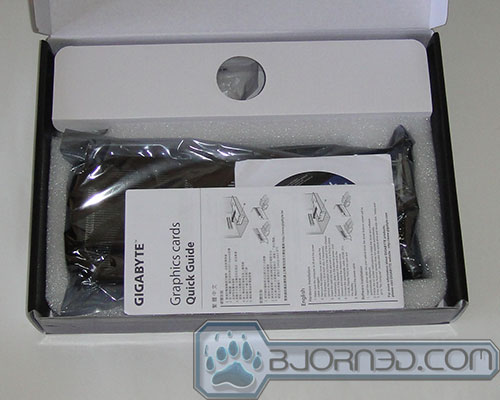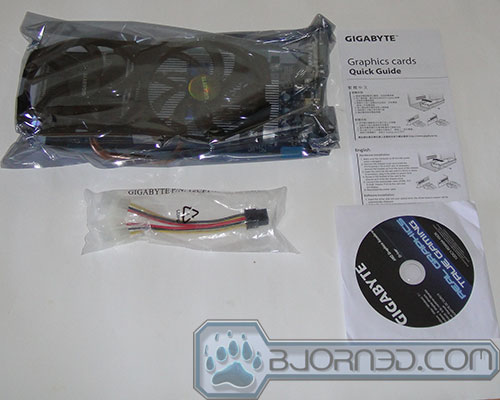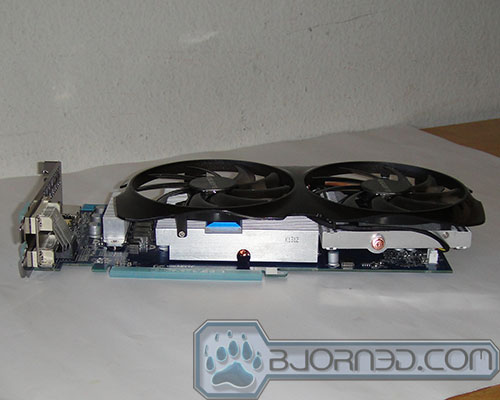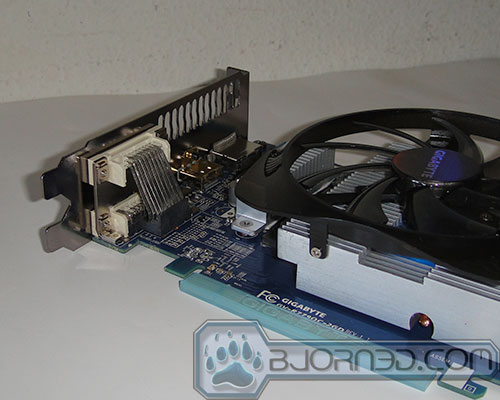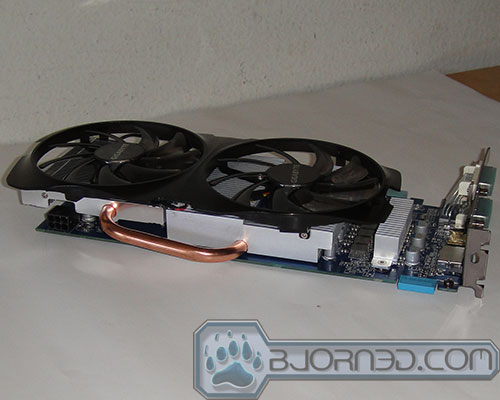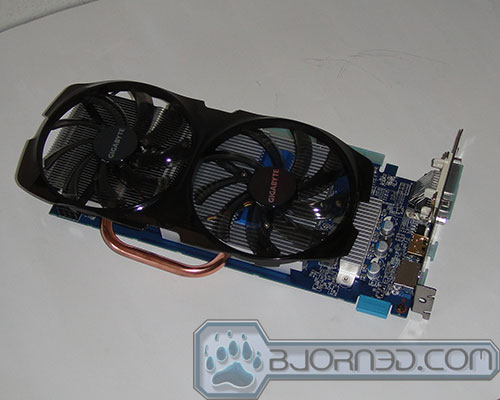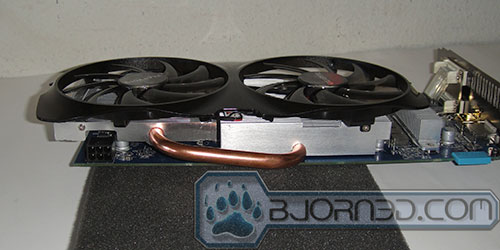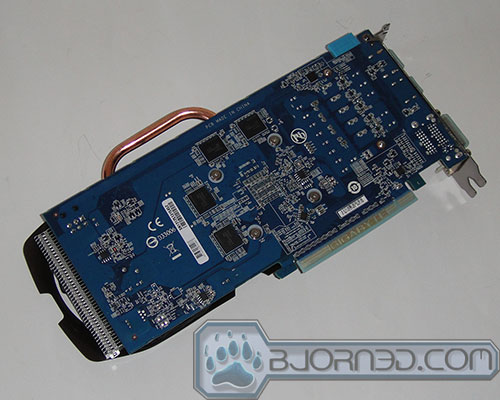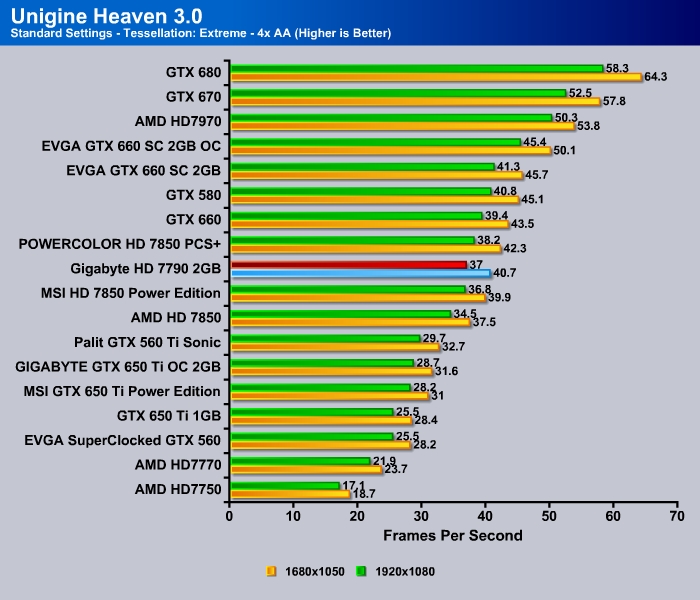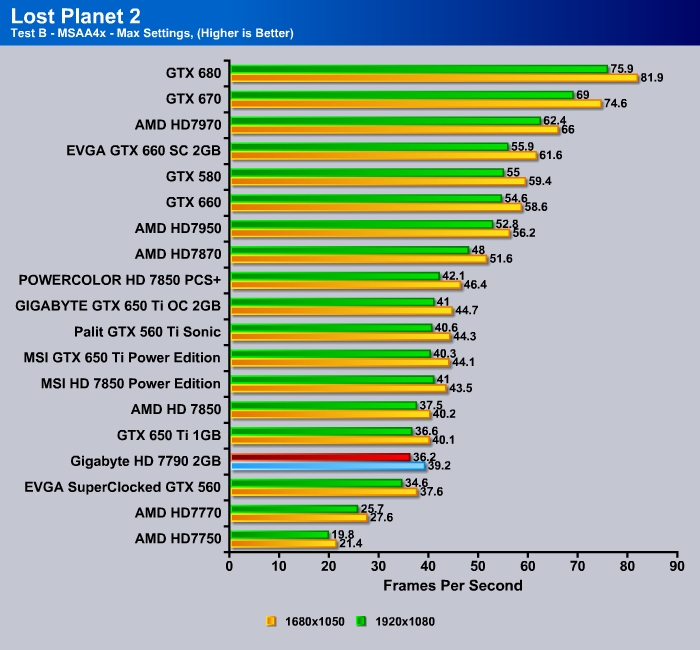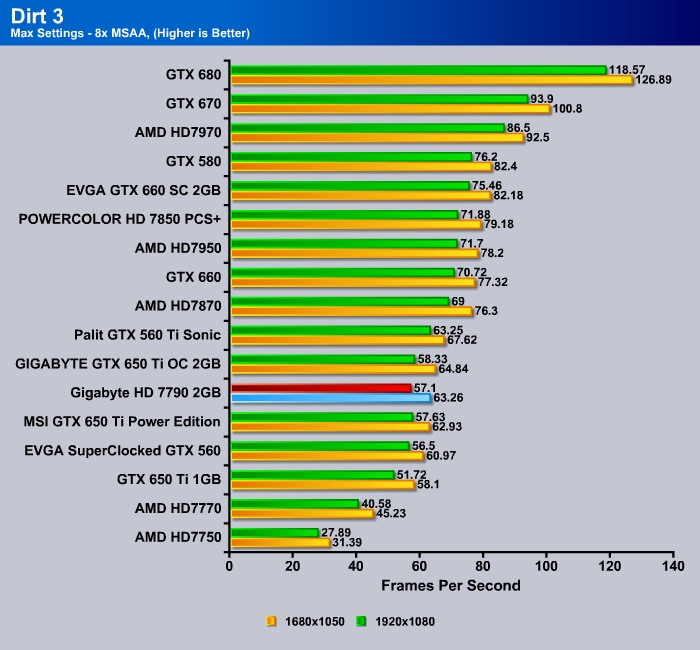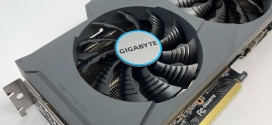The Gigabyte HD 7790 (GV-R779OC-2GD) comes with Gigabyte’s own custom designed WINDFORCE x2 cooler, factory overclocked to 1075 MHz, and 2 GB of GDDR5. Does it worth your hard-earn money with the retailed price of $169.99, let’s find out.

Introduction
The Radeon HD 7790 is the first card launched from AMD this year that is aimed to fill the $150 price bracket gap left in its line up. The Radeon HD 7790 continues to use the same Graphic Core Next (GNC) architecture that was used on the existing HD 7000 card. As the numbering of the card indicates, the HD 7790 falls between the Radeon HD 7850 and the Radeon HD 7770. If we compare the specification against the HD 7770, we can see that the HD 7790 is packed with 40% more Stream processor and texture units, which works out to be 896 and 56 respectively. The HD 7850, on the other hand is packed with 14% more stream processor and texture units than the HD 7790. Despite the same 128-bit memory as the HD 7770, the HD 7790 boasts 6 GHz of GDDR5 as oppose to the 4.5GHz on the HD 7770 and 4.8 GHz on the HD 7850 (though the HD 7850’s memory is a 256-bit). Since both the HD 7790 and the HD 7770 are clocked at the same 1GHz so we should expect that the additional performance gain coming strictly from the added functional units and the extra memory memory clockspeed.
When AMD launched the HD 7790, we are a bit to see that the reference card only comes with 1GB of memory since we feel that midrange GPU at 150 should all come with 2GB onboard memory as a standard Luckily, manufacturers are quick to respond and they quickly have launched 2GB version to the market. We have previously reviewed the Sapphire’s card and today we are going to take a look at Gigabyte’s take on the HD 7790 with the GV-R779OC02GD.
Gigabyte HD 7790 2GB
The Gigabyte HD 7790 arrived in a black and purple cardboard box. On the front, we can see it highlights some features of the card such as OC to 1075MHz and the WINDFORCE cooler. More information about the card’s Triangle Cool Fan can be found on the rear of the box.
Inside, we can see the card is placed in an antistatic bag and being protected by plastic foam to prevent any damages from shipping. The accessories are placed in a separate compartment.
The included bundle is pretty scarce where we get a quick guide, the drive CD, and a molex to PCIE power adapter. Luckily AMD has extended their Never Settle Reloaded to the HD 7790 where you can get Far Cry 3 Blood and Dragon and BioShock Infinite for free. Not terrible bad considering the card is retailed at $150. For more information, check out AMD’s own website on how to claim the code. For the lack of the bundle, Gigabyte makes up with a generous 3 year warranty.
The first glance on the Gigabyte HD 7790 card and we can see that the card is a major departure from the reference HD 7790. The card is incredibly long for a mainstream card. Compare to the reference card’s 8.5 inch in length, the Gigabyte’s card PCB is 10 inch in length and the cooler extends the card to 10.5 inches in length. In fact, the card extends over the width of a standard ATX motherboard. We are not sure the reason behind Gigabyte’s decision of using such a long PCB but we think it is probably due to the fact that Gigabyte wants to continue to offer better cooling with their own branded WindForce cooler. However, considering the fact that the HD 7790 is geared toward mainstream gamers who may not always go for a large case with most expansion slots and the current trend of moving toward smaller and more compact system, we wonder if Gigabyte’s decision of making the HD 7790 so long would hurt it sales. Nonetheless, the card should not have any issue with standard ATX case.
Speaking of the WINDFORCE cooler, the HD 7790 comes with the GIGABYTE’s WINDFORCE 2X 100mm fansink with the Triangle Cool” technology. The cooler is designed with the triangle-shaped aluminum block into the aluminum extrusion module. This is designed to help streamlining the cool air pulled from the fan toward the aluminum fins. The result is that heat can be dissipated more effectively and the turbulence between the aluminum cooling fins can be reduced.
The blue triangle block seen above is Gigabyte’s WINDFORCE coolder design aimed to streamlining the airflow and reduces the turbulence
In addition to the aluminum fin, the cooling assembly also consists of two 100mm PWM fan sits above the cooling block and a single 8 mm copper heatpipes connects the two aluminum fins. As we can see from the images above, the whole cooling assembly is rather large and it extends the top and the front of the case.
The card is being powered by 5+1 phase power design with solid capacitors. Gigabyte placed a small heatsink on top of the PWM and the cold air pulled from the fan are directed to pass through the heatsink to help with heat dissipation. Using Gigabyte’ Ultra Durable technology, the card uses low RDS MOSFET, Ferrite Core Choke, and all solid capacitor for lower power loss, cooler operation, and longer component life span.
On the top of the card, we got the 6-pin PCIE power connector and the CrossFire connector. The HD 7790’s maximum TDP is only 10 watts higher than the PCI Express connector’s 75W so it is not going to need that beefy power supply to run the card. However, the card’s minimum requirement is 450W according to Gigabyte’s website but it is very likely that you would still able to run the card with a bit lower wattage PSU provided that it is from a reputable brand with plenty of amperage on the +12v. Graphic cards draw most power from the +12V, it is the most critical rail to check.
The HD 7790 is packed with 2GB of 128-bit GDDR5 memory. Four memory modules of 250MB (H5GQ2H24AFR-ROC) are on the front of the card and four more are located on the rear. The memory operates at 1.5V. Thee front four memory modules are being cooled by the WINDFORCE cooler while the four on the rear are not.
On the back, we got two dual-link DVI connectors (a DVI-D and a DVI-I), an HDMI, and a full size DisplayPort 1.2. The mixture of the port are identical to the reference design, down to the stacked DVI ports. Like any HD 7790, the card will support AMD’s Eyefinity technology where it can power up to six displays through a DisplayPort MST hubs. Without the hub, the card will power three displays simultaneously. The included HDMI port will support 4K displays for future proof. The HDMI port also supports protected high bit rate 7.1 channel surround sound in AC-3, AAC, Dolby TrueHD and DTS Master Audio formats.
The card supports AMD EyeSpeed that is designed to bring beautifully rich and clear video playback from contents streaming from the web. In addition, it supports the AMD Avivo HD which is a hardware acceleration support for H.264 and WMV9 so that you can offload the work to the GPU and leave the CPU for other tasks. Not only the card will help with video playback, the included AMD App Acceleration that accelerate web browser, office applications and more from CPU to GPU. The new HD Media Accelerator that includes the updated Unified Video Decoder that is capable of decoding H.264, VC-1, MPEG2 (SD and HD), MVC (Blu-ray 3D), MPEG 4 part 2 (DivX/Xvid), Adobe Flash, DXVA 1.0 and 2.0 support, and WMV HD. In addition, the updated video codec engine (VCE) supports multi-stream hardware H.264 encoder for quick video transcoding.
System Setup
| Test Rig | |
| Case | Cooler Master Storm Trooper |
| CPUs | Intel Core i7 3770K (Ivy Bridge – LGA 1155 -Z77) |
| Motherboards | Intel DZ77GA-GD65GIGABYTE Z77X-UD3H |
| Ram | Kingston HyperX Gray 4 GB (2x2GB) |
| CPU Cooler | Zalman CNPS9900 Max |
| Hard Drives | Seagate Barracuda XT 3TB |
| SSD | 1x OCZ Vertex 3 240GB SATA III 6Gb/s SSD |
Results
3DMark 11

The Gigabyte HD 7790 scored 6052 points in the 3DMark 11 benchmark score, coming just a tad under the HD 7850 and is faster than the GTX 650 Ti.
At higher setting, the card scored 1640 points, just a tad under the GTX 560 Ti and the HD 7850.
Unigine Heaven 3.0
Unigine Heaven is a benchmark program based on Unigine Corp’s latest engine, Unigine. The engine features DirectX 11, Hardware tessellation, DirectCompute, and Shader Model 5.0. All of these new technologies combined with the ability to run each card through the same exact test means this benchmark should be in our arsenal for a long time.
The 75MHz overclocking on the Gigabyte card helped out slightly with the performance where we can see the card edges out the reference HD 7850 but falls behind the PowerColor’s HD 7850 PCS+ that is also clocked at 1GHz.
Metro 2033
One of the more demanding game ever, the Metro 2033 shows the card is able to edge out the GTX 560 Ti. Despite the 75MHz overclocking, the HD 7790 is still not going to be able to out-performs the HD 7850. The more powerful HD 7850 is about 15% faster than the HD 7790 here.
Just Cause 2
Here we can see that the Gigabyte HD 7790 edges out the GTX 650 Ti that is priced at same bracket.
Lost Planet 2
In the Lost Planet 2, the HD 7790 and the GTX 650 Ti are essentially tie.
Dirt 3
Again, with the HD 7790 and the GTX 650 Ti are essentially tie in Dirt 3.
Temperature and Power Consumption
| GPU Temperatures | Celcius (ºC) |
| Idle | 32 |
| Load | 56 |
When comes to the operating temperature, the Gigabyte HD 7790 excels. The card operates at cool 32ºC idle and even under load, it keeps running cool at temperature below 60ºC. This is much cooler than the cards using AMD reference cooler.
Not only that the temperature of the card is excellent, the noise-level is also equally impressive. Under load, the fan spins at 1700 RPM (52%), which is barely audible in the system. If you are seeking for a quiet gaming card, then this may just be the card you are looking for.
| System Power Consumption | Watts(W) |
| Idle | 60 |
| Load | 217 |
We see the system’s idle power consumption is 60 watts and under load with Metro 2033, it consumes 217 watts of power. Keep in mind that the power consumption we measured is the system power consumption and not just the GPU. One of the unique feature with current generation of AMD video cards is the ZeroCore Power technology. When the connected display is in power saving mode, the GPU will shut most parts down for ultra-low idle power consumption. While the technology may not going to have such a great effect for a single display, it certainly would come in handy for multiple GPU configuration where if the second card is not being used, it will shut down to reduce power consumption. So you can expect the idle temperature to be even lower if the display in standby mode.
Overclocking
We had high hopes with overclocking of the Gigabyte’s HD 7790 since the card runs extremely cool even under load. Unfortunately, it appears that the card suffered the same issue as every other HD 7790 that it cannot be oveclocked passed what AMD’s own OverDrive limitation of 1200 MHz core and 1600 MHz memory. The limitation seems to be set by the card’s BIOS and no matter what software we use, we just could not get it any higher speed. In the past, we were able to push other AMD cards with the Sapphire TriXXX for higher speed. However, with the HD 7790, the setting just return back to 1200MHz and 1600MHz despite the fact the software allows us to raise to higher value. We are a bit sadden to see that with such a great cooling solution could not provide us with an amazing overclocking potential.
Conclusion

If we have to be picky, we would like see the Gigabyte HD 7790 to come in the reference card’s length of 8.5 inches as oppose to 10.5 inches long. We think Gigabyte can actually rework the cooler slightly to fit the reference PCB as oppose to extend the length of the card. Heck, we even would not mind trading maybe a bit of cooling performance for a slightly shorter card. Especially since the card’s oveclocking is limited.
Overall, the Gigabyte HD 7790 2GB (GV-R779OC-2GD) offers good bang for the bucks. Despite its design shortcoming, it is still a good mainstream gaming card as long as you are not going to put it inside a small form factor PC then you can enjoy super quiet operation during the intensive gaming battle.
| Pros | Cons |
|
Good cooling performance Low noise-level Good performance 3 year warranty Multiple monitor support–up to 6 displays 2GB GDDR5 memory Low power consumption Factory overclocked |
10.5 inches long Limited overclocking potential |
Review Overview
Performance
Value
Quality
Features
Innovation
The Gigabyte HD 7790 2GB (GV-R779OC-2GD) design may not please everyone especially if you are looking to build a small form factor PC. However, it runs quiet and cool and provides good performance and price ratio.
 Bjorn3D.com Bjorn3d.com – Satisfying Your Daily Tech Cravings Since 1996
Bjorn3D.com Bjorn3d.com – Satisfying Your Daily Tech Cravings Since 1996
